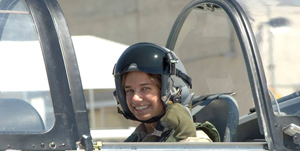|
The Missouri Space Grant Consortium (MOSGC) has identified the recruiting and training of students at NASA Centers and Academies as a top priority. Over the last four years the MOSGC has recruited and funded 22 students in this capacity. We asked some of the students to share their experience, excitement, and describe some of the activities that they were involved in their programs in several NASA Research Centers and Academies around the country. We hope that you will find these student articles informative and enjoyable as well.
 I have greatly enjoyed working at NASAís Dryden Flight Research Center through the cooperative (co-op) student program. The smaller atmosphere at Dryden has been a wonderful place to learn from the best and work with those people on a daily basis. I returned for my second rotation this summer as a member of the Operations Engineering (OE) branch. I was given the opportunity to work on several projects, some in the flight phase, and others in the modification phase before flight. I have greatly enjoyed working at NASAís Dryden Flight Research Center through the cooperative (co-op) student program. The smaller atmosphere at Dryden has been a wonderful place to learn from the best and work with those people on a daily basis. I returned for my second rotation this summer as a member of the Operations Engineering (OE) branch. I was given the opportunity to work on several projects, some in the flight phase, and others in the modification phase before flight.
One of my mentors, Carrie Rhoades, is the operations engineer for the Intelligent Flight Control System (IFCS) on one of Drydenís F-15ís. I would attend project meetings, engineering meetings and configuration control meetings usually on a weekly basis. These meetings allowed all of the team members to be updated on the other branchesí progress or work being done for the project. While Carrie was gone for F-16 training, I was put in charge of scheduling the project for a functional check flight, preparing slides for a crew brief beforehand, and updating the team about the status of the aircraft, due to maintenance. For the functional check flight, I was the flight director in the control room, relaying between the other team members and the mission controller, who spoke directly to the pilot. Also, due to the number of new members of the IFCS project team, two mission control training simulation flights were flown. For both of these flights, I acted as the mission controller alongside Carrie. These training sessions helped to teach the engineers proper radio communication and etiquette in the control room. As well, the sessions allowed the pilot to fly certain research maneuvers, giving the engineers a chance to see how the actual aircraft might respond in a certain situation. My second mentor, Tim Krall, was a graduate from the University of Missouri-Rolla and I enjoyed working with him on various projects. He was the operations engineer for the research F-18ís at Dryden. These aircraft were in the maintenance phase for the duration of the summer. One of the F-18ís was being returned to standard flight conditions in terms of the leading edge flap configuration. It was previously used in the Advanced Aeroelastic Wing project and the leading edge flaps were separated mechanically so that on each wing, one flap could go down while the adjacent one would come up. Once this de-modification is complete, the IFCS project will migrate over to the F-18.
I enjoyed my experience overall this summer; at work and outside of work with the other students and younger full-time employees. There are many wonderful sights to see in California and I cannot wait to go back next summer to work and enjoy the scenery. ~ - Michelle Rader, University of Missouri Rolla
|







